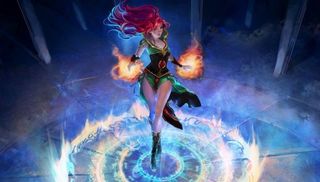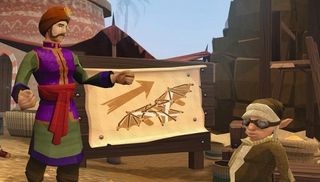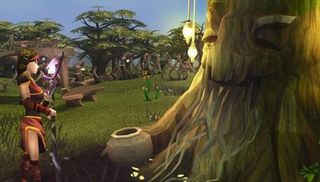Runescape 3 preview: how one of the world's longest-running MMOs plans to hand control to its players

This article was originally published in PC Gamer UK issue 252 .
RuneScape is more than 12 years old. It's one of the world's longest-running and enduringly popular MMOs, and yet it's not a game that gets talked about very much. There are reasons for that: a long silence on the part of its developers, Jagex, one of the largest independent studios in Britain – they've traditionally preferred to work with their community directly. Then there's the prevalent feeling that browser games are less legitimate than a program you need to install, a notion that the last decade in games has shown to be totally outdated. Finally there's the relatively insular and self-sustaining nature of the game's community: a central core of passionate people for whom RuneScape is their game, to the exclusion of other MMOs.
“On one level, it's been great,” says Jagex CEO Mark Gerhard, who has been with the company since 2009. “When your friend told you [about RuneScape] it was like 'wow, I've just discovered something'. Perhaps that was a better moment than if you'd approached it cynically because it had been advertised to you – I don't know. But I think we missed out a bit, as an organisation, to get players to understand what we're passionate about and the kind of experiences we want to give them.”
In truth, there are as many RuneScapes as there are people who have played it. For many, it was the free MMO that they played on the lunchroom computers at school; for others, it is one of the most hardcore levelling challenges out there.
An entire community of players built a PvP scene around the ruleset of the game circa 2007, and their protests at subsequent changes to the combat system led Jagex to set up an alternative, time-capsule version of the game for them to play – a situation that represents both the developer's willingness to be lead by their players, and the challenge of trying to please everyone for 12 years. “[Those players] are more connected to a game that existed some time ago,” explains design director Mark Ogilvie. “I don't have a problem with that. If they still want to play that game, that's absolutely fine.”

The majority of players, Ogilvie argues, want to see change. “They want to see something that is reacting all the time – otherwise, they wouldn't be consuming content at the rate they do.”
Jagex have stuck to a gruelling weekly update schedule for close to the entirety of RuneScape's life, adding new quests, minigames (selfcontained challenges) and building on the story of the world of Gielinor. In that time, several updates have gone further – making major changes to game systems and the underlying Java-based engine that Jagex have built from scratch. These include 2008's RuneScape HD, a top-down upgrade to the game's visuals. Last year's 'evolution of combat' update brought battle up to speed with modern MMOs, adding active skills and a hotbar. None, however, have gone as far or changed as much as 2004's RuneScape 2, which saw the game move from sprites to full 3D in a new rendering engine with rethought mechanics.
The biggest gaming news, reviews and hardware deals
Keep up to date with the most important stories and the best deals, as picked by the PC Gamer team.
RuneScape 3 is due in the next few months, and it's the biggest change to the game – for players and Jagex alike – since that time. “Every few years we want to do something really big, really special, something that's a significant step forward,” says executive producer Phil Mansell. “We want to make a big improvement to the game on every single front.” In order to shore up the game against changing web standards and to enable Jagex to take greater advantage of modern hardware, RuneScape has been totally rebuilt for a new engine. While the Java client will still be supported, the developers have spent the last year working on a new version of the game powered by HTML5. This means no Java updates to install and consistent performance across devices – including tablets. The game will no longer be as CPU-intensive as it once was, with rendering now liable to be handed off to graphics hardware: a change that pays dividends for the game's visuals across the board. Dynamic lighting, shadows, normal maps and reflective water are all supported, and the game's customary 'wall of mist' effect caused by a low draw distance can effectively be pushed back to the horizon.
I'm shown the HTML5 version of RuneScape running on a conference room computer. There's optimisation work to be done still, but the difference is striking. In terms of pure fidelity, the game is still some way behind the technical standard set by modern client-based games, but it is nonetheless very impressive to see a streaming browser game achieve a level of quality we'd have accepted from a boxed product a few years ago. The change also has huge ramifications for the game itself.

Outside Shantay Pass, in the deserts near the city of Al Kharid, there's a top-end combat minigame set in a massive edifice called The Dominion Tower. It's the size of a small town, bright red – and until RuneScape 3 it has been possible to run past it 20 yards away and not realise it was there. With the draw distance extended, Gielinor becomes a different place. Jagex now have the power to tell a story through the environment in a way that they simply haven't had before.
It also means that they're capable of bringing the camera down to the player's level. Traditionally, RuneScape has been controlled from a top-down perspective with limited mobility. As part of a suite of changes to the RuneScape 3 interface, the camera can now be dropped right down to close third-person – greatly enhancing the game's sense of place.
RuneScape's UI has grown continually since the game's release. Almost every update – and there have been a lot of them – has necessitated some new feature. As a result there's a lot of fat in the existing system, and navigating it as a new player can be confusing. RuneScape 3 will feature an entirely new, totally customisable interface system. Windows can be freely moved, resized, and swapped out for other options. The system will launch with a range of selected presets – including a classic style for veterans – and players will be able to create and save their own. It'll now be possible to have one interface for when you're fishing, one for when you're dungeoneering, and another for PvP – or a minimal UI for when you're playing in a smaller window. Impressively, the UI dynamically reconfigures to match window size, maintaining the principles of the basic layout but matching a wide variety of possible dimensions – bear in mind that, as a browser game, RuneScape isn't bound to traditional monitor aspect ratios.
Joining in 2011, Chris made his start with PC Gamer turning beautiful trees into magazines, first as a writer and later as deputy editor. Once PCG's reluctant MMO champion , his discovery of Dota 2 in 2012 led him to much darker, stranger places. In 2015, Chris became the editor of PC Gamer Pro, overseeing our online coverage of competitive gaming and esports. He left in 2017, and can be now found making games and recording the Crate & Crowbar podcast.
Most Popular


